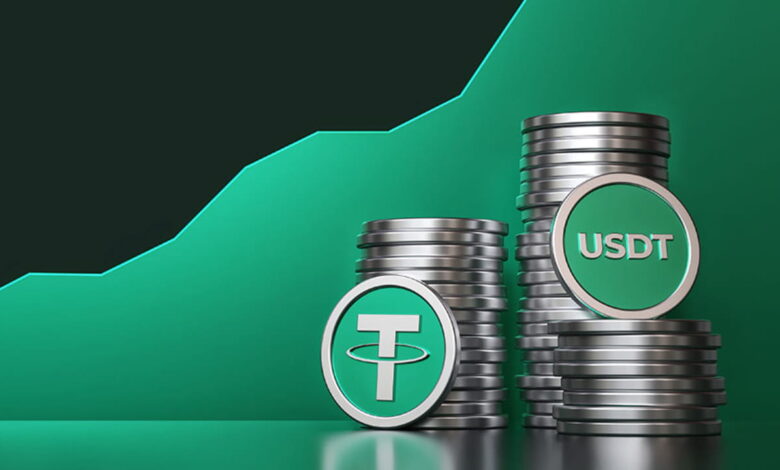$1.33B Ethereum Whale Transfers $120M USDT to Binance
A massive Ethereum whale holding $120M USDT to Binance. What this crypto transfer means for the market and potential price impact.

Ethereum whale controlling assets worth approximately $1.33 billion has made headlines by transferring another $120 million in USDT (Tether) to the popular cryptocurrency exchange Binance. This substantial transaction has captured the attention of traders, analysts, and enthusiasts worldwide, raising questions about the whale’s intentions and the potential implications for the broader digital asset market.
Understanding whale activity is crucial for anyone involved in cryptocurrency trading or investment. These large-scale transfers often precede significant market movements, $120M USDT to Binance: whether bullish or bearish. When a wallet holding over a billion dollars worth of digital assets makes a move, it’s not just about the numbers—it’s about market sentiment, potential trading strategies, and the psychological impact on millions of retail investors watching from the sidelines.
In this comprehensive analysis, we’ll dive deep into the details of this massive transfer, examine what it could mean for Ethereum and the broader cryptocurrency market, explore the historical context of similar whale movements, and provide insights into how traders and investors should interpret such events. Whether you’re a seasoned crypto veteran or a newcomer trying to understand market dynamics, this breakdown will equip you with the knowledge needed to navigate these turbulent waters.
The Ethereum Whale’s Massive Holdings
Before we dissect the recent $120 million USDT transfer, it’s essential to understand the sheer magnitude of this particular cryptocurrency whale. With a portfolio valued at approximately $1.33 billion, this entity represents one of the most significant holders in the Ethereum ecosystem. Such substantial holdings indicate either an early investor who accumulated ETH during its infancy, an institutional player managing enormous capital, or possibly an exchange or custodial service managing client assets.
The composition of a whale’s portfolio matters significantly. In this case, the whale’s diverse holdings suggest a sophisticated investment strategy rather than simple accumulation. The fact that they hold substantial amounts of both Ethereum and stablecoins like USDT indicates active portfolio management and readiness to capitalize on market opportunities. Stablecoin transfers to exchanges are particularly noteworthy because they often signal preparation for significant trading activity.
Whale wallets of this size don’t operate in isolation. They’re monitored by thousands of blockchain analysts, automated tracking systems, and curious investors using on-chain analysis tools. Every transaction is visible on the blockchain, creating a transparent yet mysterious dynamic where movements are public but intentions remain private. This transparency has given rise to an entire industry of whale watchers who attempt to predict market movements based on these large-scale transactions.
The accumulation of such wealth in the cryptocurrency space represents both the enormous opportunities and risks inherent in digital assets. Early Ethereum investors who believed in the technology when it was valued at single or double digits have seen astronomical returns. However, managing such wealth requires sophisticated security measures, strategic planning, and careful execution to avoid creating unwanted market volatility.
Breaking Down the $120 Million USDT Transfer to Binance
The recent transfer of $120 million in USDT to Binance represents a significant event that deserves careful examination. On-chain data reveals that this transaction was executed smoothly, with the funds moving from the whale’s wallet address directly to a known Binance deposit address. The transaction fees were minimal compared to the transfer amount, showcasing one of the advantages of blockchain technology for large-scale fund movements.
Binance, as the world’s largest cryptocurrency exchange by trading volume, serves as the primary destination for traders looking to execute substantial positions. When such a massive amount of stablecoins lands on an exchange, it typically indicates one of several scenarios: the whale is preparing to purchase cryptocurrencies, they’re positioning for potential market opportunities, or they’re consolidating funds for liquidity management purposes.
The choice of USDT rather than other stablecoins is noteworthy. Tether remains the most liquid stablecoin in the cryptocurrency ecosystem, offering deep order books and widespread trading pair availability across virtually every major cryptocurrency. This liquidity is crucial when dealing with transactions of this magnitude, as it ensures minimal slippage and efficient execution regardless of market conditions.
Transaction timing also plays a critical role in interpretation. The crypto market operates in cycles influenced by various factors, including regulatory news, technological developments, macroeconomic conditions, and seasonal patterns. Analyzing when this transfer occurred in relation to recent market movements provides valuable context. Was it during a market dip, suggesting accumulation intent? Or did it occur during a rally, potentially indicating profit-taking preparations?
The methodology behind such transfers also reveals sophistication. Large holders typically don’t move funds haphazardly. They employ advanced security protocols, use multi-signature wallets, conduct test transactions, and time their moves to minimize market impact. The smooth execution of this $120 million transfer suggests experienced management and professional-grade operational procedures.
What This Movement Means: $120M USDT to Binance
Whale activity serves as a barometer for market sentiment and potential future movements. When a billion-dollar whale transfers significant funds to an exchange, the cryptocurrency community collectively holds its breath, anticipating what might come next. Historical data shows correlation—though not causation—between large exchange inflows and subsequent market volatility.
The psychological impact of such movements cannot be overstated. Retail investors often interpret large exchange deposits as bearish signals, assuming whales are preparing to sell and potentially crash prices. However, this interpretation is overly simplistic and often incorrect. Sophisticated holders transfer funds to exchanges for various reasons including swing trading, arbitrage opportunities, providing liquidity, or simply portfolio rebalancing.
Market makers and institutional traders view these movements differently than retail participants. For them, whale activity represents opportunity rather than threat. Large stablecoin deposits create potential demand that can support prices during buying pressure. Professional traders position themselves accordingly, setting up orders to capitalize on whatever action the whale takes while managing their risk exposure carefully.
The Ethereum ecosystem has matured significantly since its early days, developing deeper liquidity and more sophisticated market infrastructure. This maturation means that individual transactions, even of $120 million, have less proportional impact than they would have had several years ago. Nevertheless, when combined with other whale movements or during periods of low liquidity, such transfers can still catalyze significant price action.
Correlation with broader market trends provides additional context. Is this whale movement isolated, or part of a pattern involving multiple large holders? Are other significant addresses showing similar behavior? These questions help analysts distinguish between individual whale strategies and potential coordinated movements that could signal major market shifts.
Historical Context of Similar Whale Transfers
Examining historical precedents helps illuminate the significance of current events. The cryptocurrency market has witnessed numerous instances of massive whale transfers over the years, each teaching valuable lessons about market dynamics and whale behavior. Some transfers preceded major bull runs, while others occurred immediately before significant corrections.
One notable pattern involves exchange inflows during market bottoms. Contrary to intuitive assumptions, some of the largest stablecoin transfers to exchanges have occurred when sentiment was extremely bearish, with whales accumulating discounted assets while retail investors panic-sold. These strategic accumulations often resulted in substantial profits as markets eventually recovered and rallied to new highs.
Conversely, large cryptocurrency withdrawals from exchanges typically signal bullish conviction, with holders moving assets to cold storage for long-term holding. The current scenario involves stablecoin deposits, placing it in a different category that requires nuanced interpretation. Stablecoins represent dry powder—capital ready for deployment but not yet committed to any particular cryptocurrency position.
The 2017 bull run and subsequent 2018 bear market provided countless case studies of whale behavior. Many large holders who moved significant funds during late 2017 were taking profits near cycle tops, while those transferring during 2018’s depths were accumulating what would become highly profitable positions by 2020 and 2021. These historical patterns inform current analysis, though each cycle presents unique characteristics.
Recent years have seen increased sophistication in whale behavior. $120M USDT to Binance: Modern large holders employ algorithmic trading, utilize multiple exchanges simultaneously, engage in options and derivatives markets, and coordinate their activities across various blockchain networks. $120M USDT to Binance: This complexity makes simple interpretations of individual transfers increasingly inadequate without comprehensive analysis.
Potential Scenarios and Market Implications
Several plausible scenarios could explain this $120 million USDT transfer, each with different implications for market participants. The first scenario involves an accumulation strategy, $120M USDT to Binance: where the whale is preparing to purchase Ethereum or other cryptocurrencies at current prices or during anticipated dips. This bullish interpretation suggests confidence in medium to long-term price appreciation.
The second scenario involves active trading rather than strategic accumulation. Sophisticated whales don’t simply buy and hold—they actively manage positions, $120M USDT to Binance: taking profits during rallies and re-entering during corrections. The stablecoin deposit could facilitate swing trading strategies designed to capitalize on short-term volatility while maintaining overall exposure to the cryptocurrency market.
A third possibility involves liquidity provision or market-making activities. Some large holders earn substantial returns by providing liquidity to trading pairs, collecting fees while maintaining relatively market-neutral positions. This interpretation suggests the whale may not be making directional bets but rather facilitating market efficiency while generating passive income.
Portfolio rebalancing represents another rational explanation. A holder with $1.33 billion in cryptocurrency assets likely maintains target allocation percentages across different assets and strategies. Periodic rebalancing ensures these targets are maintained as individual holdings fluctuate in value. The current transfer might simply represent routine portfolio management rather than any specific market view.
The least desirable scenario from a bullish perspective involves profit-taking or risk reduction. If the whale believes current prices represent local or absolute tops, they might be preparing to convert volatile cryptocurrency holdings into stable assets. However, the direction of this transfer—stablecoins to exchange rather than crypto from exchange—makes this interpretation less likely for immediate action.
How Traders Should Interpret Whale Activity
For retail traders and investors, understanding how to interpret whale movements without overreacting is crucial for success. The first principle is recognizing that individual transactions, even large ones, provide incomplete information. One transfer tells a limited story—patterns and contexts reveal much more than isolated events.
Smart traders use whale activity as one data point among many rather than the sole basis for trading decisions. Technical analysis, fundamental evaluation, sentiment indicators, macroeconomic factors, and regulatory developments all contribute to a comprehensive market assessment. Whale watching complements these tools but shouldn’t replace them entirely.
Timing considerations are paramount when responding to whale activity. Rushing to mimic whale movements often results in poor execution and unintended consequences. By the time retail investors identify and react to whale transfers, the immediate market impact has often already occurred. More valuable is understanding the broader strategy and positioning accordingly for subsequent moves.
Risk management remains essential regardless of whale activity interpretation. Even if analysis suggests a whale’s bullish intentions, maintaining appropriate position sizing, stop-losses, and portfolio diversification protects capital against unexpected outcomes. Whales themselves occasionally make mistakes or encounter unforeseen market conditions that invalidate their initial strategies.
The democratization of blockchain analysis tools means retail participants have unprecedented access to whale activity data. Platforms like Etherscan, Whale Alert, and specialized analytics services provide real-time notifications and historical tracking. Learning to use these tools effectively while avoiding information overload represents a valuable skill for modern cryptocurrency participants.
The Broader Implications for Ethereum and DeFi
Beyond immediate price speculation, this whale activity reflects broader trends in the Ethereum network and decentralized finance ecosystem. Large holders moving substantial stablecoin amounts demonstrate continued confidence in centralized exchanges as trading venues despite the growth of decentralized alternatives. This suggests that for high-value transactions requiring deep liquidity, traditional exchange infrastructure still offers advantages.
The choice of Ethereum-based assets for such massive holdings validates the network’s position as the premier platform for high-value cryptocurrency activity. Despite competition from newer blockchains offering faster transactions and lower fees, Ethereum’s security, liquidity, and established ecosystem keep it central to professional cryptocurrency operations.
Stablecoin dynamics play an increasingly important role in cryptocurrency markets. The existence of reliable, liquid stablecoins like USDT enables sophisticated trading strategies impossible in purely volatile crypto-to-crypto markets. This stablecoin liquidity serves as crucial market infrastructure, facilitating price discovery and capital efficiency across the entire ecosystem.
The interaction between large holders and exchanges shapes market microstructure in important ways. Exchanges adjust their operations, $120M USDT to Binance: liquidity provision, and security measures based on expectations of large client activity. When billion-dollar whales operate on a platform, it signals trust and capabilities that benefit all users through improved infrastructure and services.
Looking forward, the continued presence and activity of large holders suggest long-term confidence in cryptocurrency as an asset class. $120M USDT to Binance: Despite periodic corrections and regulatory uncertainties, the fact that sophisticated investors maintain and actively manage billion-dollar cryptocurrency portfolios indicates a belief in the technology’s enduring value and growth potential.
Conclusion
The recent transfer of $120 million USDT to Binance by a whale controlling $1.33 billion in cryptocurrency assets represents a significant event worthy of attention and analysis. $120M USDT to Binance: While the specific intentions behind this movement remain known only to the whale itself, $120M USDT to Binance: the transfer provides valuable insights into market dynamics, whale behavior patterns, and the current state of cryptocurrency infrastructure.
For market participants, $120M USDT to Binance: the key takeaway is balanced interpretation. Whale activity deserves attention as one component of comprehensive market analysis, but it shouldn’t drive emotional, reactionary trading decisions. The most successful cryptocurrency investors and traders combine on-chain analysis with technical evaluation, fundamental research, and disciplined risk management to navigate volatile markets effectively.
The broader context suggests a maturing cryptocurrency market where billion-dollar holders actively manage sophisticated portfolios across multiple platforms and strategies. $120M USDT to Binance: This institutional-grade activity coexists with retail participation, $120M USDT to Binance: creating dynamic markets that offer opportunities for informed participants while punishing those who chase movements without understanding underlying dynamics.
As the cryptocurrency ecosystem continues evolving, whale watching will remain relevant but increasingly complex. $120M USDT to Binance: The tools, data, and analytical frameworks available to retail participants continue improving, democratizing insights previously available only to institutional players. $120M USDT to Binance: Education and disciplined application of these tools separate successful long-term participants from those caught in cycles of hope and disappointment.
Ultimately, this $120 million transfer reminds us that cryptocurrency markets operate 24/7 with constant activity from participants ranging from small retail traders to billion-dollar whales. $120M USDT to Binance: Understanding this dynamic ecosystem, $120M USDT to Binance: respecting its complexity, $120M USDT to Binance: and maintaining disciplined strategies positions participants for success regardless of what any individual whale does next.
FAQs
1. What is a cryptocurrency whale, and why do their movements matter?
A cryptocurrency whale is an individual or entity holding extremely large amounts of digital assets—typically enough to influence market prices through their trading activity. $120M USDT to Binance: Their movements matter because large transactions can signal market sentiment shifts, create liquidity changes.
Q: Does transferring stablecoins to an exchange always mean the whale is preparing to buy?
Not necessarily. While stablecoin transfers to exchanges often indicate preparation for purchasing cryptocurrencies, $120M USDT to Binance: they can also signal intentions for active trading, $120M USDT to Binance: arbitrage opportunities, liquidity provision, or simply consolidating funds for easier management.
Q: How can retail investors track whale activity in real-time?
Retail investors can monitor whale movements using several blockchain analysis tools, including Whale Alert (which provides real-time notifications of large transactions), $120M USDT to Binance: Etherscan for Ethereum network activity, and specialized platforms like Glassnode or CryptoQuant that offer comprehensive on-chain analytics.
Q: Should I copy whale trading strategies if I identify their patterns?
Copying whale strategies is rarely advisable for retail investors due to several factors: whales operate with different risk tolerances, $120M USDT to Binance: capital levels, $120M USDT to Binance: and time horizons than typical retail traders. By the time whale movements are identified and analyzed, market conditions may have changed significantly.
Q: What’s the difference between exchange inflows and outflows in terms of market sentiment?
Generally, cryptocurrency outflows from exchanges (moving to private wallets) are interpreted as bullish signals indicating holders are securing assets for long-term storage rather than immediate selling. $120M USDT to Binance: Conversely, $120M USDT to Binance: cryptocurrency inflows to exchanges often raise concerns about potential selling pressure.









